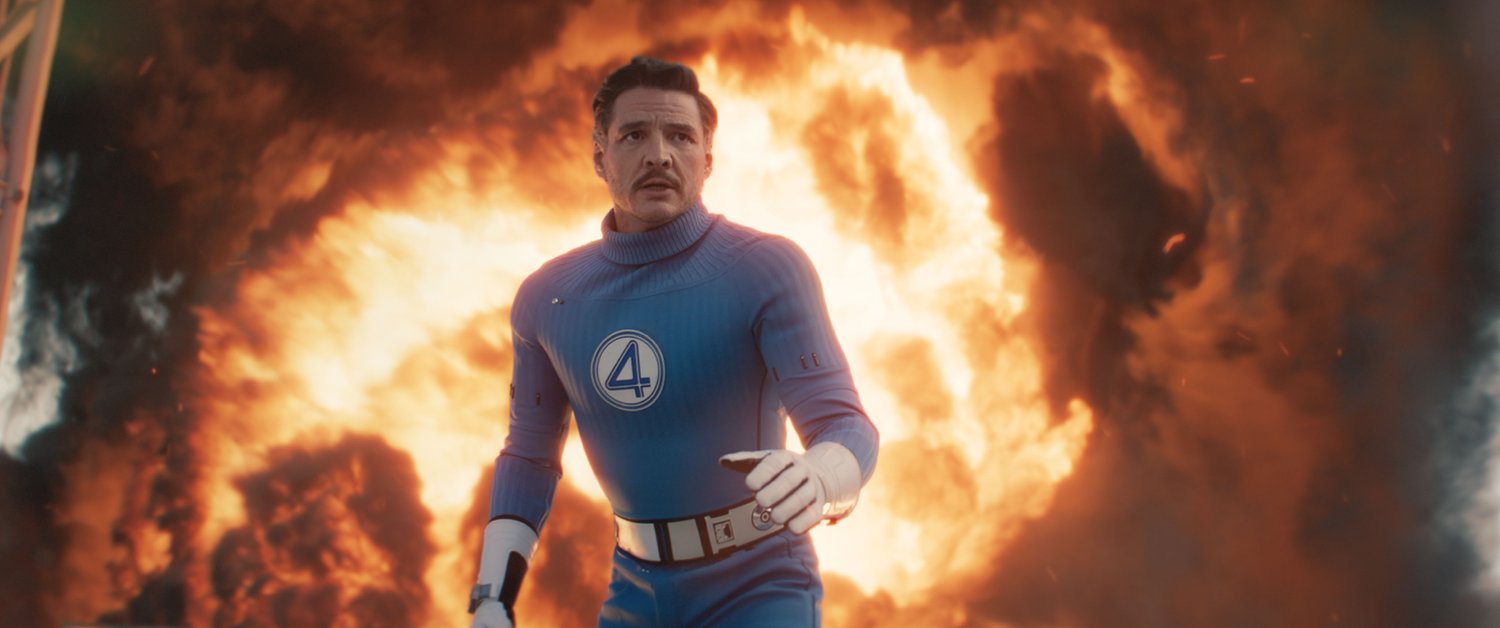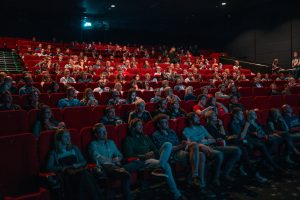Images courtesy of Walt Disney and Marvel Studios
THE FANTASTIC FOUR: FIRST STEPS— 4 STARS
Ever since mega-producer Kevin Feige and the braintrust at Marvel Studios enacted their master blueprint with The Avengers thirteen years ago, the Marvel Cinematic Universe has become a grand experiment in group dynamics. It’s thrived on intriguing dream pairings ripped from the comic book pages who are forced to put away egos and competing agendas to work as a team, resulting in all sorts of chummy buddies and a smattering of occasional love interests. In that time, the MCU has never come close to depicting a legitimate family unit. The closest it ever got was the Maximov twins in Avengers: Age of Ultron and Tony Stark’s post-Blip daughter Morgan in Avengers: Endgame, both of which were tiny subplots in huge movies and had their futures wrenched away by the end of their respective movies.
Since their comic book debut in 1961 from Jack Kirby and Stan Lee, one of the most essential axioms of The Fantastic Four is the unbreakable bond of family. Appropriately nicknamed “Marvel’s First Family,” the traditional team contained a married couple working alongside a brother/brother-in-law and a close family friend who would become a godfather to future children. They operate with a wholly different dynamic than part-time friends who are a rallying call and a fist-bump away from helping their newfound peers again when the need arises.
LESSON #1: THE UNIQUE DYNAMICS OF FAMILIES— The familial conveniences and inconveniences of The Fantastic Four are unique. Their Baxter Building headquarters of labs and workshops in New York City is also a shared residence. Working and living with each other creates a higher level of unity compared to folks that come and go as they place. Reed Richards, Susan Storm, Johnny Storm, and Ben Grimm share career history, communicative shorthand, a robotic sidekick, nightly meals together, a souped-up team vehicle, and, most importantly, responsibility to each other that is greater than their heroic public causes. Compared to, say, The Avengers, blood is thicker than Gatorade.
Living up to its subtitle to venture into a higher level of solidarity, The Fantastic Four: First Steps presents the proper elevated level of accountability and character connection that comes with family. From that genealogical bedrock, all of the other emerging drama and tension is granted extra ounces, pounds, and tons of importance. By addressing and including such emphasis, this new foray succeeds mightily where previous cinematic interpretations have failed.
Diverging from the mainline MCU, the year is 1964 on Earth-828, a multiverse branch far from 1994, 2005, 2007, 2015, and sweet cameo from John Krasinski. With extreme kudos to the production design of Loki’s Kasra Farahani, the massive art direction fleet, and the wondrous tactile inventiveness for the prop work, this world’s New York City looks like a stylish smash between the domestic functionality of The Jetsons and industrial kitsch of architect and designer Eero Saarinen. Introduced in this timeline by a primetime television talk show’s narrated montage recapping their origin and their ensuing exploits as astronauts bombarded by cosmic rays which altered their genetic makeup and granted them superpowers, The Fantastic Four (Mr. 2025 Pedro Pascal, Pieces of a Woman Oscar nominee Vanessa Kirby, Gladiator II heel Joseph Quinn, and two-time The Bear Emmy winner Ebon Moss-Bachrach) have operated as trusted scientific leaders, popular tabloid figures, and Earth’s sole protectors. Four years into their uniformed collaboration, all three of those labels are put to the test by the events of The Fantastic Four: First Steps.
After years of trying and abandoned hope, Sue Storm (Kirby) finds out she is pregnant and shares the news with her family and the general public, creating enormous public sentiment. Adding newfound domestic parenting challenges to his chalkboarded checklist of equations and scenarios, Reed Richards (Pascal) finds himself stretched thin (pun intended). Meanwhile, his best friend Ben Grimm (Moss-Bachrach) and brother-in-law (Quinn) are finding their best routes to play future uncles and fit into their adoring Big Apple community.
Their final label of Earth’s sole protectors is put to the test by the arrival of Shalla-Bal (Ozark Emmy winner Julia Garner), the cosmically quick space-faring herald of the ancient planet-consuming behemoth Galactus (Ralph Ineson of Nosferatu). Dubbed “The Silver Surfer” by Johnny and the watching media, she informs the masses that Earth has been marked for destruction and to enjoy their final days. Answering the panicked public pressure, The Fantastic Four board their Excelsior (insert Stan Lee wink) spacecraft to confront Galactus directly and bargain for Earth’s survival. In doing so, they fail and learn Galactus is after more than just a global meal.
From there, The Fantastic Four: First Steps, written by the quartet of Kingdom of the Planets of the Apes’s Josh Friedman, Thor: Ragarok’s Eric Pearson, Jeff Kaplan of the indie Bert and Andie’s Guide to Friendship, and first-timer Ian Springer, spins its own movie version of the well-regarded “Coming of Galactus” storyline. The comic book faithful and general trolls out there will welcome an immensely powerful and comic-accurate Galactus, even if he still looks like a massive and gaudy special effect. They will, however, need to make peace with a different sort of screenplay hodgepodge that is out to do its own thing without the exposition of Uatu the Watcher, the human linchpin Alicia Masters, and the handy Ultimate Nullifier device. Those classic elements are streamlined into a course of anticipatory preparations and the exploration of hypotheses of what could possibly deter or defeat the coming menace.
LESSON #2: CASTING FOR FAMILY CHEMISTRY— For the most part, every task for confronting the arriving extinction machine is channeled through that aforementioned family dynamic, where each member of The Fantastic Four takes on their own piece of dilemma. To hit the right feels and build balanced, believable connection, casting for family chemistry is key. In my eyes, about half of the four are crafted well for this new blockbuster.
In any family, who’s the strongest person? The answer isn’t the big guy with a rocky exterior ready for “clobberin’ time” or the hotshot who can fly with infinite elemental powers of impressive fire. It’s the vigilant mom, the emotionally-composed matriarch, and the recipient of “happy wife/happy life” chestnuts. Vanessa Kirby is downright perfect in conveying the everlasting will, reserve, and love that comprises the core of Sue Storm. Her protective forcefields are built as much by those tremendous personal traits as they are by psionic energy. She’s the best character in the entire movie.
Who screws up the most in the family? Regrettably, it tends to be dad, overwhelmed by self-blame and a put-upon sense of obligation. While Reed is brilliant and remains the constant man-with-the-plan, Pedro Pascal is sapped of a great deal of his innate charm, looking confounded most of the time by mathematical calculations or downtrodden by his fatalistic tendency to examine the direst odds. I’ll going ahead and say it. I miss the potential that was winsome grins and doting affection that was possible from John Krasinski.
Alongside the power couple, The Fantastic Four: First Steps splits the difference of the other two men. The humanizing Jewish roots of Ben Grimm for Ebon Moss-Bachrach are given a nod with burgeoning neighborhood ties, embodied by Natasha Lyonne’s schoolteacher Rachel Rozman, but his overall scope is too slight. Favorably, the film cools down the usually feisty and free-spirited side of Johnny Storm in favor of granting him his own agency to prove his intellectual usefulness next to the other geniuses in the room. Joseph Quinn’s progression melds slightly with a detrimentally shortened arc granted to the Silver Surfer, whose face turn position as a difference maker deserved more time and climactic impact.
LESSON #3: SOMETHING BIGGER THAN YOURSELF— No matter the Disney property—Marvel, Pixar, or otherwise—when the time comes, they’ve always been in a hurry to get to the action. While the significance of family is strongly woven, The Fantastic Four: First Steps often finds itself in quite a rush at the helm of director Matt Shakman, promoted from the TV ranks of WandaVision and It’s Always Sunny in Philadelphia. Luckily, the roller coaster initiative is for the right cause when, at a pivotal point of mounting fear, Sue addresses the public imploring for everyone, superpowered or otherwise, to connect to, fight for, and have something bigger than yourself. It’s the stump speech of the whole movie, spoken to fabulous truth and leading to the universal drive to face, fight, and defeat obstacles together. Those ideals are simple, but they always work.
Even if there are some weaknesses in portrayal and dramatic execution, enough of the positive efforts shine bright. That inescapable and pervading spirit of family wins over all else for The Fantastic Four: First Steps, just as it should. Top flight composer Michael Giacchino, working closer to his adventurous Lightyear motifs than the booming Star Trek work on his luminous resume, gives his lifting surge in the spirit department with a solid, memorable score. Best of all, operating in a separate (for now) realm with no ties to the exhausting multiverse BS of the rest of the MCU, Shakman’s film is a liberating entertainment experience that requires little to no homework, making it an ideal entry point and launching pad for new audiences.
LOGO DESIGNED BY MEENTS ILLUSTRATED (#1324)



